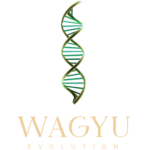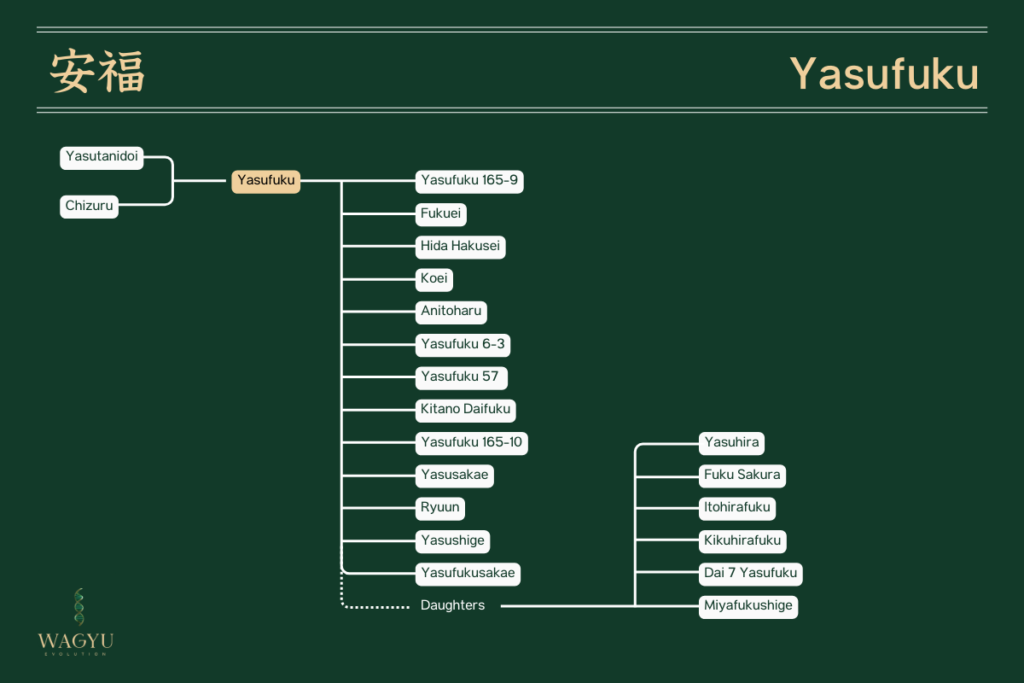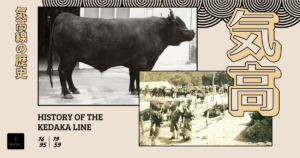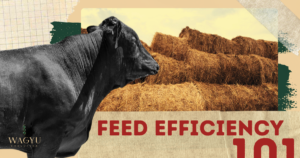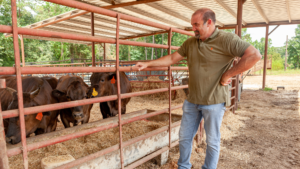Yasufuku: A Paragon Of Wagyu Excellence
Table of Contents
* Note: This is not a direct translation of Kenichi Ono’s “Top 100 Famous Beef of Japan [Revised Edition]” but a summary that was written using it as a direct source.
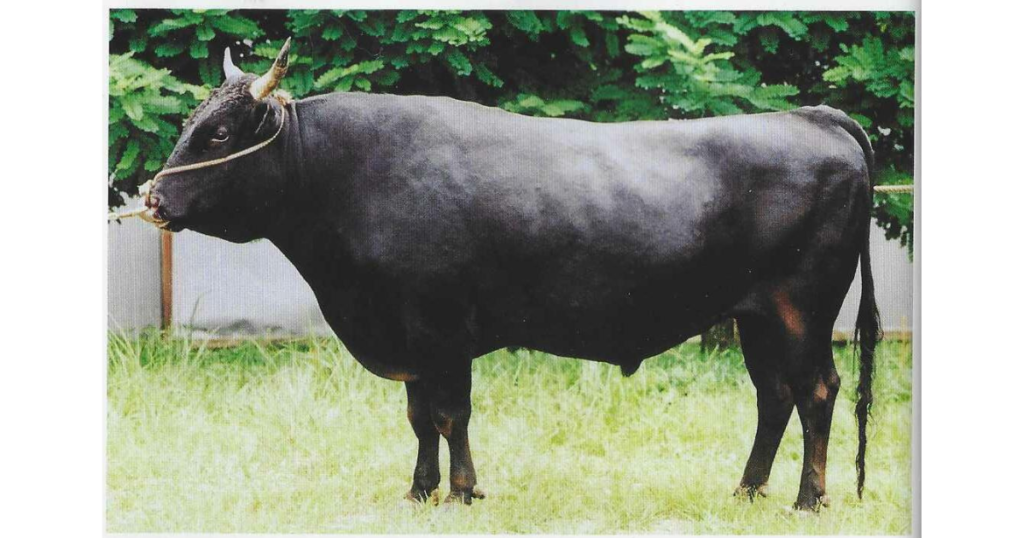
Figure 1. Yasufuku
Background
“Yasufuku,” now a renowned representative of Japan’s black Wagyu breed. He was born on April 1, 1980, at the home of Mr. Shichigosan Inoue in Muraoka Town, Mikata District, Hyogo Prefecture. His sire was “Yasutanioi,” who was still undergoing meat production testing at that time. His dam’s sire was “Yasumidoi,” who was at the height of his popularity then, and Yasufuku was the third offspring of his dam, Chizuru. (See his pedigree in Table 1)
The bull auction in June of the following year (1981) was exceptionally fruitful. Including the bulls that did not participate in the auction, Yasufuku’s contemporaries included renowned bulls like Yasuko Doi, Tanimoto Doi (owned by Hyogo Prefecture), Kanayama (owned by Fukushima), and Kikutani (owned by Iwate), all of which went on to represent their respective prefectures. Yasufuku was auctioned off to Gifu Prefecture for 10 million yen ($68,880 USD), and was renamed “Yasufuku” by the governor himself (he was originally named “Fukubi”).
From the fall of that year, he was actively used, and following the indirect testing in May 1984, where he recorded top results among Gifu Prefecture’s breeding bulls, his popularity soared. Along with the branding of “Hida beef,” and Yasufuku became widely known among livestock professionals across Japan by the early 1990s. Until his death at the age of 13 on September 28, 1993, Yasufuku produced approximately 80,000 straws of semen.
Features
Strengths: Weight gain, Large ribeye area, Uniformity, Body conformation, Shoulder thickness, Meat quality, Meat color, Fine texture, Good marbling in the hip area, High yield rate, Strong genetic power, Early maturity
Weaknesses: Occasional appearance of abnormal hair color, Fat necrosis, Genetic diseases due to breeding between carriers (CL16 positive), Difficult temperament
Yasufuku is considered one of the most balanced modern Wagyu bulls.
Yasufuku: A Paragon of Wagyu Excellence
Yasufuku can be considered one of the most exemplary Wagyu bulls. At his peak, the carcass quality of Yasufuku was the epitome of Wagyu capabilities, a perfect specimen (Kenichi Ono frequently visited the Aichi Meat Market at the time and often observed the carcasses of Yasufuku’s offspring).
As a result of the focus on weight gain in Wagyu breeding improvements since the 1970s, today’s average Wagyu tends to have significantly less marbling in the round and sirloin compared to the chuck roll.
The emergence of the Yasufuku line, which improved upon this deficiency, is seen as a savior not only by producers but also by the meat industry. Yasuhira from Miyazaki, closely related to Yasufuku, is also of the same type.
Pedigree Background
Yasufuku, along with Kikukuni from Iwate Prefecture and Yasutani Fuku from Kagoshima Prefecture, was among the early offspring of Yasutanidoi (they were born during his youth). Additionally, he was the third offspring of Chizuru at the age of five. This makes Yasufuku an excellent example of a breeding bull born from the close inbreeding of a young bull and a young cow.
Although recent breeding values tend to rate older cattle highly due to data collection perspectives, it’s crucial to note that breeding ability can sometimes decline with age. Ideally, breeding improvements should be conducted using younger cattle, and Kenichi Ono believes that the estimation of abilities can be sufficiently managed through the use of cloned cattle and embryo transfer (ET).
Yasufuku’s great-grandfather, Tokutokudoi, is renowned as the sire of the famous bull Kotoku from Iwate Prefecture. His great-great-grandfather, Shigekanenami, has produced many renowned bulls nationwide, including Shigeshigenami from Miyagi. Incidentally, Shigefuji, who became Yasufuku’s best partner in Gifu, is also a descendant of Shigekanenami. Yasufuku, backed by such an excellent lineage, has produced numerous successor bulls.
Major Successor Bulls
Yasufuku, possessing strong genetic power, produced the following successor bulls (breeding bulls) from his initial few offspring:
Bulls with Yasufuku as the Sire:
- Yasufuku 165-9 (used by the Livestock Improvement Association of Japan, Morioka) (CL16 positive)
Yasufuku’s name became widely known throughout Japan even more due to his offspring Yasufuku 165-9. The winning rate of the Yasufuku 165-9 lineage in various competitions at the Tokyo Meat Market has been the top-ranked by far in recent years. At the Maesawa Beef Competition in 1995, the only Yasufuku 165-9 offspring presented won the grand prize (thanks to the farmer’s excellent fattening techniques). The Yasufuku 165-9 offspring, apart from occasional occurrences of abnormal hair color and fat necrosis, are manageable cattle with few accidents, suitable for group rearing, and possess good meat quality and weight gain. The remaining straws should be carefully used for female retention (Yasufuku 165-9 died in 1992).
- Yasusakae (Yasusakae, Gifu Prefectural Livestock Experiment Station) (CL16+)
The representative successor bull from Yasufuku’s hometown, Gifu Prefecture, is Yasusakae. This bull has been used for many years as the first breeding bull of Yasufuku’s offspring. The maternal line’s Shingetsu is from Okayama’s Shiniyada 4 lineage, while the third and fourth generations consist of the renowned Hyogo’s Monpyo lineage, indicating the high capabilities of the maternal cow Shingetsu 59.
Yasusakae’s strong points include the particularly good carcass performance in inbred offspring with Yasufuku’s daughters. If the dam possesses average-level abilities, consistent results are achieved. (Yasusakae passed away in 1997.)
Bulls with Yasufuku’s offspring as the Sire:
- Ryuun (Gifu Prefectural Livestock Experiment Station)
- Grandsire: Shingetsu (CL16)
- High ability but unfortunately died young. His full brother, Anmo, also died early after being used for breeding.
- Koei (Livestock Improvement Association of Japan, Morioka)
- Born: March 18, 1983
- Grandsire: Shigefuji (CL16+)
- Koei II (Gifu Prefectural Livestock Experiment Station)
- Born: February 12, 1986
- Same grandsire as Koei (CL16+)
Koei and Koei II are siblings, with Koei being particularly widely used across the country. Offspring of these bulls tend to inherit the maternal abilities well. However, cows with narrow shoulders may show variability in fattening performance, which requires attention.
- Anitoharu
- Born: October 31, 1985
- Grandsire: The 7th Itosakura
Anitoharu was used in the Ena region of Gifu Prefecture with good performance and is now used throughout the prefecture. It was also temporarily used in Iwate. Both weight gain and meat quality are stable. His full brother, Yasufuku Sakura (Iwate Prefecture), is also in use with positive feedback (both bulls are CL16).
- Yasufukusakae (Livestock Improvement Association of Japan)
- Born: January 6, 1991
- Grandsire: Otsusha 6 (CL16)
Yasufukusakae is notable for good weight gain, strong constitution, and high economic efficiency, although the backline is slightly loose.
Notable Successor Bulls Across Various Prefectures
Yasufuku’s progeny have become notable sires in various regions, including Hokkaido, Nagano, Yamaguchi, Nagasaki, and Kagoshima and other prefectures.
Bulls Sired by Yasufuku:
- Yasuhira (Miyazaki Livestock Improvement Association)
- Born: April 12, 1989
- Origin: Sadowara, Miyazaki Prefecture
- Breeder: Masazumi Nagano
- Sire: Yasufuku (same name bull, used in Miyazaki, sired by Tadayasudoi)
- Grandsire: Yasufuku (used in Gifu)
- Great-grandsire: Shigefuji
- Indirect Testing: DG 0.95, BMS 3.0, Loin Eye Area 53 cm² (Top nationwide in 1991)
Among the bulls carrying Yasufuku’s bloodline, Kenichi Ono believe that Yasuhira closely matches Yasufuku in terms of ability. His fattened offspring display exceptional loin thickness and shoulder width, consistently winning top awards at carcass exhibitions not only in Miyazaki but also across various regions in Japan.
The dam, Kiyofuku, is known as a super cow, with all her male offspring registered as sires. Half-sibling Fuku Sakura matched Yasuhira’s performance with DG 1.02 and BMS 3.4 in indirect testing in December 1995 and is currently in use.
Breeding Considerations & Recommendations
Inbreeding:
Inbreeding should be limited to producing feeder calves. For breeding heifers, outcrossing is recommended to promote growth and prevent weaknesses and genetic diseases.
Crossbreeding Recommendations:
Crossbreeding with lines such as Shigekane and Itosakura, which showed good compatibility with Yasufuku in Gifu Prefecture, is recommended. These lines can help compensate for Yasufuku’s narrower loin eye area and improve midsection growth. This practice is recommended for producers in Fukushima and Kagoshima.
By considering these breeding strategies, Yasufuku’s legacy can be further enhanced while addressing specific genetic traits and improving overall herd performance.
References
小野健一. 日本名牛百選〔改訂版〕(pp.13-22). 肉牛新報社.
